Stay in the know on all smart updates of your favorite topics.
Circular Challenge: How Can We Stimulate Circular Business Models in the Electric Vehicle Charging Infrastructure Chain?
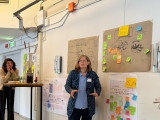
Circular initiatives often struggle to progress beyond the pilot phase, including circular charging infrastructure. Numerous barriers hinder these circular initiatives:
• Lack of data on products and how circular/sustainable they are.
• Difficulty in implementing circularity across the entire production chain.
• Regulatory obstacles.
• Current higher costs associated with circular production, leading to more expensive products.
To overcome these barriers, adjustments to regulations are necessary to better align with circular initiatives, alongside the establishment of shared ownership within the production chain.
Research project - Shifting circular: urban infrastructure and policy changes towards renewed territorial metabolisms
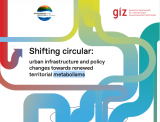
Find out this comparative analysis of critical policies and infrastructures essential for advancing the urban circular transition!
This piece of work draws upon the insights garnered from the experiences of four European cities, including Amsterdam. Reflecting on pivotal levers and obstacles pivotal in catalyzing socio-ecological transformations towards alternative urban metabolisms forms the crux of this exploration. This insightful report, commissioned by the Deutsche Gesellschaft für Internationale Zusammenarbeit (GIZ), the German agency for international cooperation, has been recently unveiled within the Circular Economy Solutions Dialogue (CESD) under the auspices of the Think20 (T20) working group focused on sustainable urbanization.
As a PhD researcher, I am now embarked on another research project on circular policies and strategies. One of my fieldwork is based in Amsterdam, spanning from January to April 2024. I am enthusiastic about establishing connections and potentially collaborating during my stay in the city!
CINDERELA living lab

From urine to plant 'food'
CINDERELA is a demonstration plant that transforms urine into nutrient-rich fertilizer. The plant is located at Marineterrein Amsterdam Living Lab (MALL), and consists of a refurbished shipping container – containing a laboratory and two urine-diverting toilets – and an adjacent greenhouse which also serves as a meeting space.
Visitors of the Marineterrein who use the toilets can witness how their urine is stabilized and purified in a bioreactor, and then distilled and concentrated into organic plant 'food'. At the demonstration plant, the urine is separated by the diverting toilets after which it is treated and 100% converted to usable raw material streams: nutrient-rich fertilizer and 'clean' water.
These two resulting products: the fertilizer – free of bad odor, pathogens or micropollutants – and water, will be used in the greenhouse and vegetable garden adjacent container, showcasing how nutrient-recovery technologies can be implemented to turn waste into resources and close the nutrient loop/create circular food systems.
Toilets that 'save' urine from the sewage system
So what actually makes urine a valuable organic waste stream? Its Nitrogen and Phosphorus content makes it a good fertilizer and compost accelerator. However, as you can imagine, it needs to be treated first to remove its bad odor and contaminants. In our innovative CINDERELA project, all available nutrients are recovered from urine.
In order to achieve this, a new type of toilet is used – developed by EAWAG, EOOS and LAUFEN – which looks just like a normal toilet. The only difference is that these toilets have an internal curved section that catches liquid on and around the bowl. By collecting the urine before it ends up in the sewage system, these toilets allow this waste stream to be re-purposed.
Separating urine before it ends up in the sewage systems is an effective recovery approach, as urine makes up roughly ~1.5% of the volume of sewage yet contains ~55% of its Phosphorus content and 80% of the Nitrogen (the two main nutrients needed for a fertilizer).
CINDERELA’s urine to fertilizer process is largely based on the “VUNA” process developed by scientists at EAWAG. “Aurin” is the resulting fertilizer commercialized by EAWAG’s spinoff “VUNA”.
Why is it important to recover nutrients from our wastewater?
Nitrogen and Phosphorus are among the nutrients which can be recovered from urine. These two nutrients together with other macro- and micronutrients are essential for plant growth and thus the production of our food.
However, the current model for managing these nutrients in our food cycle is out of balance and unsustainable. Modern agriculture relies heavily on the use of mineral/synthetic fertilizers as a source of nutrients. This is problematic because both the production and usage of these nutrients cause problems:
(1) production of mineral/synthetic fertilizers is dependent on fossil and mineral reserves. Nitrogen fertilizers are derived from the energy-intensive conversion of atmospheric nitrogen into ammonia (known as the Haber-Boshprocess). Phosphorus is obtained from the mining of phosphate rock reserves, which are finite and limited to a few locations around the globe.
(2) the intensive use of fertilizers is increasing (roughly doubling) the input of available nitrogen and phosphorus into natural ecosystems which has severe ecological consequences. The over availability of fertilizers used on fields ends up in our water systems. This causes eutrophication: a dense growth of plant life that can disrupt existing eco-systems.
Circular use of Nitrogen (N) and Phosphorus (P) (e.g. recycling the nutrients in our wastewater back to food production) is essential to, on the one hand, reduce our dependency on fossil and mineral reserves, and on the other avoid the negative ecological impact of “waste” nutrients ending up in the environment.
Closing the loops
The process of transforming urine into fertilizer in itself sounds innovative, we can imagine. On its own, this concept of recovering nutrients from urine is not new as there are several projects in place in which this is done. There are however a few reasons why our CINDERELA project is particularly innovative:
- Firstly, let's start of with the way the urine is collected in this project. In many cases, projects (can) only make use of urinals. The toilets available in this project can be used by anyone, which enables us to collect greater amounts of this waste stream, without the need to change user's habits.
- Secondly, many of the existing projects that focus on recovering nutrients from urine are limited to retrieving struvite (which contains phosphorus, and limited amounts of nitrogen). In this project, all available nutrients are retrieved. Adding to this, the residual water, after struvite recovery, is still water waste. At the CINDERELA demonstration plant, the full urine stream is treaded and reused. Plants and greens will be grown with the recovered nutrients as well as the water;
- Thirdly, at this living lab plastic is collected separately – according to type and quality – to be recycled using AM techniques. After washing and grinding this plastic, it is used in 3D printing to make components to build a customizable freestanding planted wall – a perfect spot for the plants and greens to grow.
- Last but not least, 'closing the loop' with regard to all the above: the CINDERELA living lab contributes to creating a local circular system as the entire loop of organic and inorganic waste streams is closed; from urine to fertilizer and water, from plastic to a plant-wall.
Larger project scope
This experiment is part of a larger European project that focuses on recycling resources and waste material in the construction center. The overall objective of CINDERELA is to unlock the potential for a resource-efficient urban and peri-urban construction sector by developing a new Circular Economy Business Model (CEBM) for use of secondary raw materials (SRM) produced from different waste streams – such as wastewater – within urban and peri-urban area. Read more about the project here.
Space for Food: Space technology for sustainable food systems on Earth
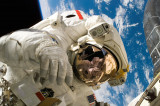
A big part of innovation in space technology revolves around finding smart, efficient and circular ways to establish a life support system for the astronauts going on the trip. Since it’s simply impossible to bring an end-less amount of resources on board, how do you make sure the astronauts can eat, drink and breath?
What if we view “cities as spaceships”; in terms of urban environments being ‘closed-loop systems’? This gives way to the idea that the same space technology developed by ESA could be applied to increase circularity in a city like Amsterdam.
Towards circular resource streams
Municipal wastewater is a great resource for nutrients and water reuse. The Space for Food project aims to use space technology in recovering nutrients and cleaning wastewater that can be used in food production using vertical farming. Closing the loops from waste to resource will help improving the impact in the environment, while creating resilience for the cities.
For this reason, the project will test a proof of concept using a raceway reactor for purple bacteria cultivation on brewery and municipal yellow wastewater at Marineterrein Amsterdam Living Lab. The biomass will be used as slow release fertilizer and bio-stimulant for cultivation of vegetables.
Communication Alliance for a Circular Region (CACR)

De taskforce Communication Alliance for a Circular Region (CACR) wil de circulaire economie in de Metropoolregio Amsterdam versnellen met praktische verhalen voor en over ondernemers en bedrijven. We nodigen iedereen uit mee te doen met de discussie op amsterdamsmartcity.com. De CACR bestaat uit: Hogeschool van Amsterdam | Gemeente Amsterdam | Amsterdam Economic Board | Amsterdam Smart City | Metabolic en AMS Institute.
Artikelen 'Circulaire economie en data'
• Volop kansen in de nieuwe circulaire werkelijkheid / Data zijn de zuurstof van de circulaire economie: deel 1
• Slim datagebruik in de circulaire economie: de drie belangrijkste redenen / Data zijn de zuurstof van de circulaire economie: deel 2
• 100.000 bedrijven restafvalvrij in 2025
• Slim datagebruik in de circulaire economie: dit is wat bedrijven zelf kunnen doen / Data zijn de zuurstof van de circulaire economie: deel 3
Artikelen circular strategies
Maak je bedrijf toekomstbestendig met deze circulaire strategieën
--------------------------------------------------------------------------------
The taskforce Communication Alliance for a Circular Region (CACR) is working to accelerate the circular economy in the Amsterdam Metropolitan Area, sharing practical stories for and about entrepreneurs and businesses. The CACR is an initiative by Amsterdam University of Applied Sciences | City of Amsterdam | Amsterdam Economic Board | Amsterdam Smart City | Metabolic | AMS Institute.
Articles 'Circular economy and data'
• A wealth of opportunities in the new circular reality / Data is the oxygen that the circular economy thrives on: part 1
• Smart data usage in the circular economy: 3 key reasons / Data is the oxygen that the circular economy thrives on: part 2
• 100,000 companies residual waste-free by 2025
• Smart data use in the circular economy: this is what companies can do themselves / Data is the oxygen that the circular economy thrives on: part 3
Articles: Future-proof your business using circular strategies
Wicked Problems
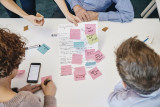
Te wicked? Niet voor ons.
Wij werken allemaal aan urgente, complexe, maatschappelijke uitdagingen. Issues die schier onoplosbaar lijken, van dilemma’s en paradoxen omgeven, nog niet duidelijk hoe het moet. Wel is duidelijk dát het moet, dat we elkaar nodig
hebben en dat we er NU aan moeten beginnen. Om met de woorden van Jan Rotmans te spreken; we leven niet in een tijdperk van verandering maar in een verandering van tijdperk. En hier hoort een nieuwe gereedschapskist bij.
En of je nou aan energietransitie werkt, andere mobiliteitssystemen, creëren van waterstofhubs, peer to peer autodeelsystemen, het maakt niet uit, we zien dat al deze opgaven op enig moment tegen gelijksoortige barrières aanlopen. Op samenwerking, financiering, privacy, onvoldoende aansluiting op de maatschappij, om maar een paar voorbeelden te noemen.
Unieke samenwerking
Als Amsterdam Smart City netwerk willen en kunnen we deze opgaven niet laten liggen. Door het bundelen van onze kennis en expertise kunnen we als netwerk iets unieks bieden en de wil en durf tonen om deze barrières te doorbreken. De betrokken partners die dit uitdenken en begeleiden zijn RHDHV, Kennisland, Drift, NEMO, Arcadis, Alliander, HvA en Metabolic. Zij bundelen hun expertise en ervaring om de echte vragen boven tafel te krijgen, tot nieuwe manieren van samenwerken te komen en barrières te doorbreken. We richten ons met name op de start van de samenwerking. Gezamenlijk ontwikkelen we een ‘wicked problem aanpak’. Op een nieuwe manier, lerend door te doen, exploratief.
Waar moet je aan denken?
Wat is eigenlijk het echte probleem? Wiens probleem is dit? Hoe kijken anderen er tegenaan? Welke andere partijen lijken nodig? Hoe vind je ze? Hoe ga je om met eigenaarschap en botsende frames? Hoe zorg je dat je al in
een vroeg stadium de maatschappij (bewoners, ondernemers, werknemers, etc) betrekt en hun ervaringen in het project trekt? Het wicked problem team zet nieuwe methoden in voor het beantwoorden van deze vragen. En het creëren van de benodigde commitment om het vraagstuk aan te pakken. Niets staat van te voren vast, want we passen ons aan aan wat we tegenkomen. Met elkaar ontwikkelen we een nieuwe aanpak om de barrières te doorbreken.
Isolde de Ridder Sieraden
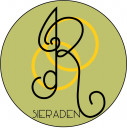
At Isolde de Ridder Sieraden, founded by Isolde de Ridder – Le Creurer in 2017, creating high-end jewellery with the greatest of care for both people and planet, is our mission. We strive to make the world more beautiful with our unique jewellery. Our unique pieces are crafted by hand in the Netherlands. Jewellery that give discarded metals and other materials a second life and that contribute to a better world for generations to come.
Upcyclecentrum Almere

In the Upcyclecentrum we make the circular economy and the upcycle process visible and tangible. We don’t do this alone. Our residents provide us with raw materials by properly separating their waste, the entrepreneurs (startups) upcycle these raw materials into new products and inspiring workshops are organized in our circular designed experience center. Waste = raw material in the circular economy; this is the central theme of all our activities.
Follow us on instagram on www.instagram.com/upcyclecentrum
#upcyclecentrum
Unravelau

Unravelau is a high-end fashion brand established in 2017 by the designer Laura Meijering who believes that you don’t have to sacrifice style in order to make conscious choices. While each collection is unique, they are all designed with care for the planet. Our garments are handcrafted in The Netherlands and made of natural and upcycled materials only. At Unravelau, we believe that every little step counts - together with you, we unravel the fashion industry. One garment at a time.
EC-Link Platform

You would like to connect with Urban Environmental Sustainability practitioners and researchers in China and exchange your approaches to green transport, clean energy, compact urban development, water and solid waste management, green buildings and municipal finance? Then sign up to the EC-Link platform! The platform links Eco Cities across Europe and China, offering inspiring examples from both sides of Eurasia and enabling direct contacts to the innovators. With the help of an integrated translation tool, posts can be translated into Chinese and English with just one click. Use of the platform is free of charge: http://eclink.org/bbs/#/?lang=en
A description of how the platform works can be downloaded here: http://eclink.org/ec_platform/upload/document/EC-Link_Users'%20Guide-EN.pdf
Parksharing: for local collaboration and sharing between businesses

The importance of working together locally, sharing together, and matching supply and demand between companies is increasing. More than ever, we see local entrepreneurs helping each other and purchasing products or services from one another. Working together from the catering industry to healthcare pays off. Parksharing enables entrepreneurs, businesses and organizations to take concrete steps towards local cooperation and sustainable entrepreneurship.
Connecting, collaborating and sustainability
We connect companies and organizations at local level through Parksharing. The platform shows which companies and organizations are in the municipality and what they can do for each other. Companies can then offer and purchase their products and services among themselves. After all, why find a distant friend when you have a good neighbor?
In addition, companies can match and share the supply and demand of company resources, materials, residual flows, services, personnel and facilities. For some companies, there is a great demand for materials, resources or extra manpower, while for other organizations equipment is idle or staff are temporarily available.
Think very concretely about: forklift trucks, storage space, parking spaces, partial mobility, residual flows and materials, transport capacity, meeting rooms, surplus stock, knowledge, sustainable projects or business cases, workplaces, technical staff and warehouse employees, for example.
PARKSHARING FOR LOCAL COLLABORATION AND SHARING
The importance of working together locally, sharing together, and matching supply and demand between companies is increasing. More than ever, we see local entrepreneurs helping each other and purchasing products or services from one another. Working together from the catering industry to healthcare pays off. Park sharing enables entrepreneurs, companies and organizations to take concrete steps towards local cooperation and sustainable entrepreneurship.
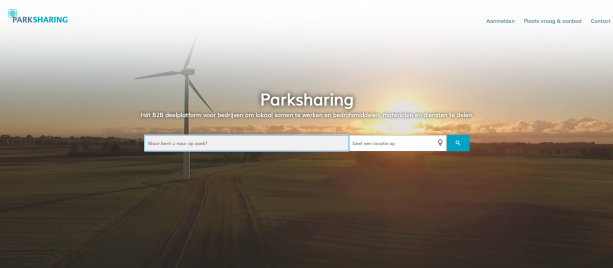
CONNECT, COLLABORATE, SHARE AND BECOME SUSTAINABLE
We connect companies and organizations at local level through Parksharing. The platform shows which companies and organizations are in the municipality and what they can do for each other. Companies can then offer and purchase their products and services among themselves. After all, why find a distant friend when you have a good neighbor?
In addition, companies can match and share the supply and demand of company resources, materials, residual flows, services, personnel and facilities. For some companies, there is a great demand for materials, resources or extra manpower, while for other organizations equipment is idle or staff are temporarily available.
Think very concretely about: forklift trucks, storage space, parking spaces, partial mobility, residual flows and materials, transport capacity, meeting rooms, surplus stock, knowledge, sustainable projects or business cases, workplaces, technical staff and warehouse employees, for example.
PARKSHARING SCAN
To accelerate this new and circular development from ownership to use, we have developed a ParkSharingScan. This allows companies to calculate in advance what they can potentially earn and save by sharing assets, materials, services and facilities, both in euros and in energy and CO2.
The first results of the SharingScan are already promising: 10.3 million euros potential savings in costs, 7.5 million CO2 savings and more than 11.5 million KwH in energy savings.
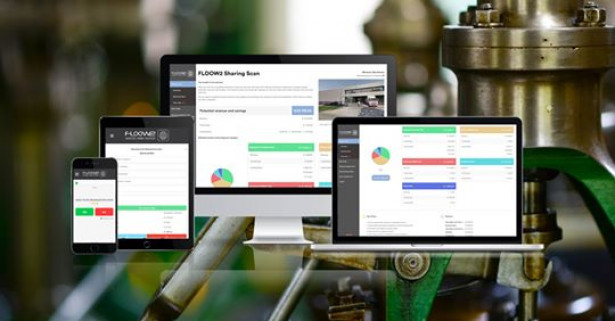
Urbact Civic eState and the Amsterdam Whole Commons Catalog

In the Urbact Civic eState project Amsterdam works together with several European cities to locally adopt progressive policies on the urban commons. As a first step the Amsterdam Foundation Onschatbare Waarde ('invaluable value’), together with Amsterdam commons initiatives, made the beautiful catalog Heel de Stad, Heel de Aarde (the whole city, the whole earth) during the past 6 months. A guide with all kinds of tips and tools, ideas and projects, people and books for everyone who is or wants to work collectively.
Heel de Stad, Heel de Aarde is inspired by the Whole Earth Catalog. Like in the original Whole Earth Catalog, experts and doers share reviews of all kinds of books and practices. The Catalog - in short - shows the positive and practical ways in which we can shape the future and shows that we not only have to look at the government or the market, but also start ourselves: in commons!
The Catalog is available online in Dutch via http://heeldeaarde.net - and you can also request one hard copy (with poster). And via https://wijamsterdam.nl/verhalen/lege-supermarkt-ga-naar-het-voedselbos you will find an interview with Natascha, the editor in chief, and a short introduction video about the commons in Amsterdam.
<http://heeldeaarde.net/> and <https://urbact.eu/civic-estate>
[►
Heel de aarde, heel de stad
Whole Commons Catalog
Gemeente Amsterdam Vimeo](https://vimeo.com/434468746)
Schijnerg Group

Creating the next-generation renewable energy digital platform, focusing on machine learning-based consulting and sustainable community. Additionally, it provides engineering consultancy which is 100% digital through machine learning optimization. Furthermore, it also transforms the data to solve unique to our client need and it embarks a lifelong companion for clients to grow from installation to decommissioning.
Bees Digital Farm

Ever since the 20th century most of the countries across the globe are still using the traditional way of farming and it’s still going on for the demand and supply of people. As we all know that by the year 2050, the 80 % estimation of the world population will have been living in urban areas which can lead the total population of the world to increase by 3 billion people. With this large amount of increase in population, scientists and researchers are quite worried about the farmland which will be required to generate such a huge demand for food supply to fulfill the necessity to survive. Noticing this fact in mind as what would be the future source of alternative solutions to solve such a type of problem a concept was proposed named “In-House Farming”.
Johnny Cashew
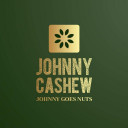
Be a superhero! Our cashew travel 12.500 km less than the cashew you will find in your local supermarket and they are better for the farmer, the environment and you.
Did you know that 90% of all cashew nuts travel 27.000 km before they end up at a store near you (3/4 the glove)? Did you know that Africa is the world largest producer, but that 90% of the nuts are being processed in Vietnam & India under harsh conditions, only to be shipped all the way back to the Netherlands?
Neither did we...
But as soon as we realized this, we started this project: Johnny Cashew. We decided to ship cashew straight from Tanzania, while making sure the farmer and the local processor got a fair price. Also, we found a home for the broken cashew nuts that are normally cast aside: we started workshops in Amsterdam to turn them into bars, pasta and maybe also a dressing on your next ice cream :).
Part of our profits will go to planting new cashew trees in Tanzania: good for the farmer, the environment and your karma.
In other words: our nuts taste good, look good and do good!
More info at www.JohnnyCashew.com
Circular Economy Course - UvA

PPLE at the University of Amsterdam is an intense interdisciplinary program for bright bachelor’s students. Within this faculty, international (including Dutch) students are brought together and posed with challenging courses designed to help them think critically about society and the world around them. These dedicated driven students typically have strong backgrounds in social sciences, however, lack education in the area of sustainability. TheRockGroup sees it as its mission to fill this gap by presenting practical societal perspectives on our current sustainability challenges.
The courses invited guest speakers from relevant societal actors (businesses, government and/or NGO’s) to provide real-life examples to students. This brought the studied theory and our class debates to a higher level. Not only did it show the relevance of what we studied, it also portrayed the complexity of current challenges in a world without perfection information.
CEDaCI – Circular Economy for the Data Center Industry

The Data Centre Industry has grown rapidly and generates a large volume of e-waste / WEEE. The current infrastructure for dealing with this waste is underdeveloped and consequently, there is a real and urgent need to address this now. CEDaCI will build a Circular Economy for the Data Centre Industry by bringing together stakeholders from all equipment life cycle stages to turn this waste into a useful resource and support the ongoing rapid growth of the DCI.
KASKANTINE 4.0

The Kaskantine will implement together with the neighboorhood its design for closing local resource loops: a kitchen with closed water cycle, preventing local food waste, introduce neighbourhood composting, and organise repair cafe's, sport and musique workshops, etc. Data will be gathered to monitor the resource cycling and methods will be tested to make it more socially and culturally inclusive.
User-created nature-based solutions in an urban environment;
The case of the KasKantine (Greenhouse Cantina), Amsterdam
Historically landscape architecture and infrastructural planning have assigned physical separated functions to landscape in order to upscale and manage resource flows cost efficiently. Rather than monosectoral and large scale linear production systems we can now see a shift to decentralized and locally integrated solutions to close resource loops. In these solutions also citizens can play a more (pro)active role. After being more prominent in rural areas, landscape architecture is now also more active as a lead design principle in urban neighbourhoods. Local integrated solutions for resource cycling efficiency give rise to multiple value production rather than to an increase of local financial income. Either way it increases citizen driven (semi)professional activities in resource management in urban neighbourhoods, as well in its creation and in management.
We see enormous potential in this approach: it can reconnect citizens to nature, it can facilitate in changing lifestyles AND produce the right technology to face our climate and resource crisis. But before it can become mainstream, we see the following challenges and questions, mainly to do with creating sufficient local political support and accessibility to these technological and economic opportunities.
- How can actors on local level on one side and central sectoral level at the other side co-create and redesign effectively the landscape, necessary to close resource loops locally with sufficient democratic legitimacy?
- How could citizen-driven services in resource management be held accountable to a broader public and the public sector?
- How can these nature-based solutions be culturally and socially inclusive?
- How can socio-economically marginal(ized|) groups profit from this increased multiple-values production?
We can try to answer those questions for one specific case to see how it could work out in practice. The Kaskantine is a not-for-profit volunteer driven garden- restaurant - food coop which has as its main objective to show that more autonomous, off the grid nature based solutions for climate adaptive working and living in urban areas are possible and can be at the same time a new lifestyle. It is a small village of refurbished shipping containers, recycled greenhouses and (roof top)gardens. The Kaskantine is currently being built on its fourth location and is negotiating a 7 years ground lease with the municipality of Amsterdam.
The Kaskantine managed to grow from only one container and a one-man company, 5 years ago, to a cooperative with over 30 volunteers with 13 containers. A second village is being planned of 7 containers in the east of Amsterdam. This has been realised without any external capital investment or subsidies. The strategy has always been: find a solution with the least possible financial costs and turn untapped local resources into value.
In doing so the Kaskantine discovered that although real estate prices in Amsterdam skyrocket, there is still a lot of underutilised land and water, that is without use for people and for nature. Lots of plots are “waiting” to be developed, or are underdeveloped: for one function while there could be double or triple functionalities. We could call this “real estate waste”. The Kaskantine could use land for free because there was no direct market value of that land. And the same counts for other important resources: (rain)water, (solar)energy, food (waste and own production), labour (volunteers) and (natural and waste) materials. The Kaskantine is able to operate with zero fixed costs and therefore able to survive.
Furthermore, with its installations it is trying to integrate all received good and services in local loops. Maximum in, minimum out. This is optimized by integrating different resource loops in one management system.
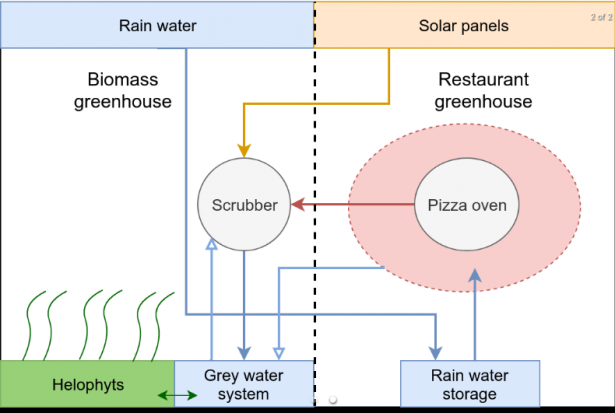
An abundance of one flow of resources can be absorbed by other resource cycles: Peak solar energy can be used in extra ventilation, aeration and irrigation. Sudden food surpluses are redistributed for free and create network solidarity. The Kaskantine is also able to use resources in all phases of their life cycle, like wood: from construction to fire wood. Or being able by using rest heat in storing it in mass or other spaces, or filtering waste water for irrigation. We call this adaptive capacity: the capacity to buffer abundance and use it later or in an alternative way.
Finally, an alternative lifestyle is embraced, one that is appreciating the value of abundance of local resources, rather than the value of market choice.
We could argue that the Kaskantine is thriving in an alternative economy, that can exist thanks to and despite of the mainstream economy that they are trying to transform. We call this abundance or give economy, in contrast with economy based on consumption and the organisation of scarcity.

Abundance economy as being a sum of relatively autonomous integrated projects in mainstream economy.
Because of its ability to expand autonomously within mainstream economy, and because its abundance economy is not a zero-sum game as long as local resources and waste are underutilised, the Kaskantine is very open for participation. There is no economic argument against including more neighborhood activities, on the contrary. More participation seems therefore to depend more on the capability of cultural inclusiveness: if people feel comfortable within the network of the Kaskantine, or if people feel comfortable to start a sort of “kaskantine” on their own.
First, the opportunity to integrate has been ”built in” into the design of the Kaskantine by a step-in approach. From experience as a guest (exchange, tasting, get inspired, etc) to participation in the design, creation and operation of the Kaskantine and Kaskantine related projects.

Secondly, the Kaskantine is also active in the neighbourhood centre and within a network of community organisations, with a step-out approach. In this case the Kaskantine offers through free workshops a learning curve to adopt small scale installations, like vertical gardens and worm composting, and participate in food saving and storage at home in order to take a step back from mainstream economy into the abundance economy.
An important ambition of the Kaskantine is to negotiate with the municipality a land lease contract in which the landuser takes responsibility for its development and environmental control of the land. This cheaper land rent will hopefully give other “kaskantines” the opportunity to arise.
The Kaskantine has free energy to spend on helping other groups in joining this movement because it can operate autonomously and with low fixed costs. This creates hopeful opportunities for inclusiveness of the proposed solutions. Whether this is done in some kind of co-creation with more central institutions depends more on their own capability to work with local small scale initiatives and on their willingness to change or compensate the negative effects of their lineair production models and on their willingness and capability to change sectoral into integrated policies.
BuurtBuik social circulair foodinitiative

Sharing is caring, as the young folks say.
BuurtBuik is all about sharing food with your neighbors. We cook meals from food that would be wasted otherwise. Thereby, bringing people together around a free three course meal and build their social network. It impacts both environmental and social goals, thus, bridging the gap to a circular social economy. Come around a see it in action, we feed 500 people three course meals every week!
Stay up to date
Get notified about new updates, opportunities or events that match your interests.


